WST - “Tell us about yourself; who is Angel Lawrie?”
Angel L. - “I am a teacher, performer, event planner, and counselor for kids at risk. I have been married to pan tuner Steve Lawrie for 11 years. I never had children of my own, but I like to think I have adoptive children around the world through my interaction with Pan!”
WST - “Talk about your introduction to the steelpan instrument.”
Angel L. - “I was exposed to the Steel Drum Artform in 1986 when I attended the University of Akron. I heard the band, and I could not sit down. I remember thinking how excited I was as a percussionist to learn that there was a new instrument to make beautiful music!”
WST - “You are a performing artist, band leader, educator, therapist, public speaker and more; is there a role you prefer, and if so, why?”
Angel L. - “I have loved every role I have had the honor to be in regarding music and the Steel Pan. Each one brought its own challenges and rewards! The one that has brought me the most joy is teaching and using the steel pan in therapy for the clients I get to work with. Every day, I get to see that light bulb go on in the eyes of my clients, and that spark of pure joy when they feel the attention and love and feedback while playing this beautiful instrument.”
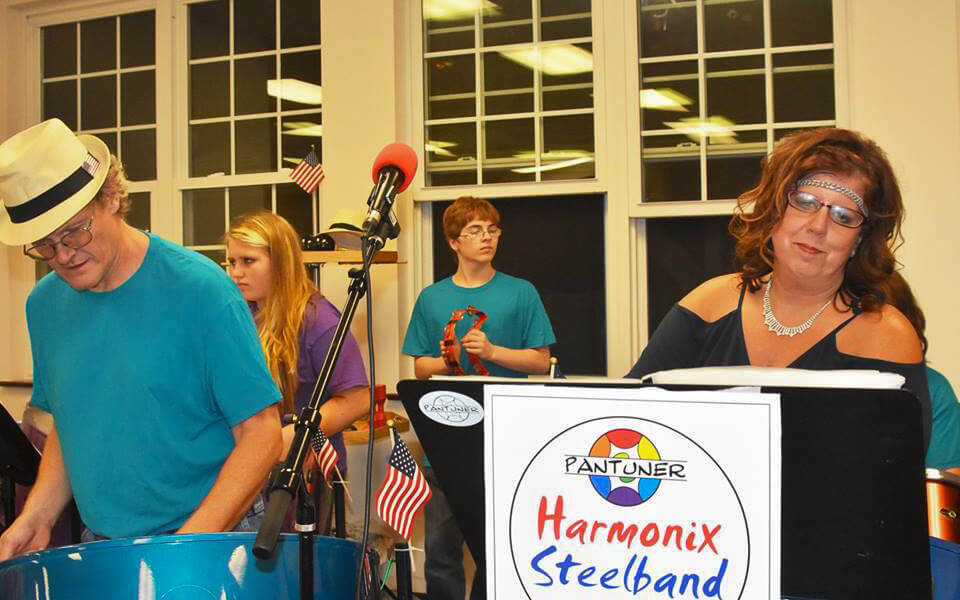
Angel Lawrie, right, with husband Steve Lawrie at left
WST - “How do these roles complement each other?”
Angel L. - “Each one of my roles interacts with the other. I use the therapeutic approach while teaching my clients new concepts. My therapeutic office is my classroom many times. The event-planning comes from the need to showcase the work being done by each of the clients. It is amazing how clearly they can see their progress when they get the chance to perform and inspire others. I’ve never really known how to do things in a small way when it comes to education. I continue performing professionally because I love it! Also, it keeps me fresh, and helps inspire me to come up with new ideas to help the clients I serve.”
WST - “In your workspace of musical therapy, the steelpan is your choice of instrument; do you believe there are advantages with the steelpan, compared to other conventional instruments in this regard? If so, please discuss.”
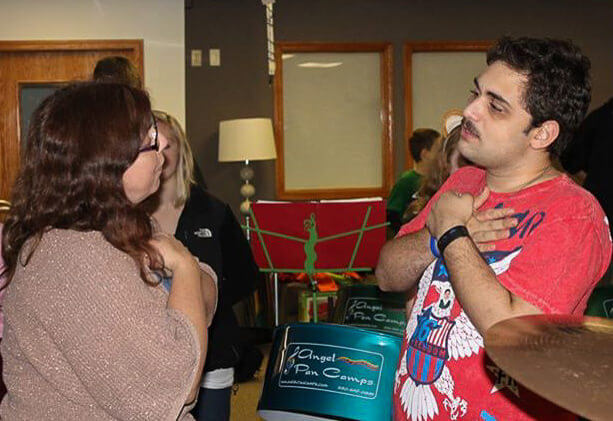
Angel Lawrie with student
Angel L. - “The steel drum is my number one choice of instrument with working with clients on the autism spectrum. I have worked with both adults and children. The steel drum allows me to physically help my clients transform as well as emotionally.
“The sound of the drum is pleasing to most ears, and the volume is just right for clients who may be sensitive to sound at first. The balance needed to play the drum helps develop the large motor skills necessary for clients on the spectrum. The arrangement of notes on the drum allow me to create several patterns that speak to the development of the left-brain right-brain concept to help clients grow emotionally as well. The energy that can be created in the teamwork, and grouping students together with different needs creates an amazing amount of energy. I have often asked many observers to stand in the middle of my therapeutic bands and feel the energy change as my clients begin to put all the pieces together. Clients who could not speak at one time are now finding ways to communicate what they are feeling.”
WST - “How do you implement the steelpan in your therapy sessions?”
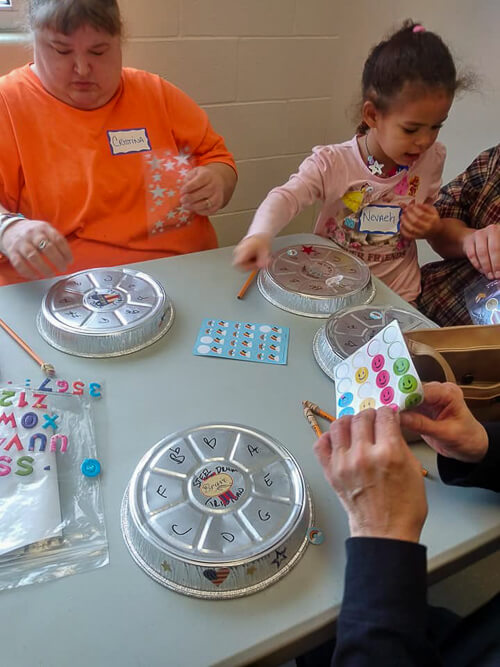
Pan camps with Angel Lawrie
Angel L. - “I use all of the voices in large group settings; I use the lead when I am working in a private session. I also have clients make artistic paper versions of pan and we use them as textbooks when drawing maps of emotions. Those maps are essential in helping students navigate through emotions that feel out of control. The maze of notes on the drums feel quite similar to what they feel in their thoughts.”
WST - “You work with students with autism spectrum disorder and ADHD. Share some insights on what you have observed from those participating, and the role of pan music in communicating with perhaps some of the more challenging scenarios?”
Angel L. - “There is no doubt that the steel pan keeps the attention of my students. However, the steel pan also allows me to achieve success faster than a traditional instrument. I am able to reach a place of understanding and accomplishment with them rather comfortably, and then the rewards can continue to expand and grow.”
WST - “Talk about some of the adaptations that you perhaps make to your customary educational methodology used, when interacting with the conventional student body and adults in general - to when teaching students with autism spectrum disorder and ADHD?”
Angel L. - “I teach my ensembles and my private clients both by rote and music reading. I have also incorporated other methods like the Suzuki Method too. I have used Pan to help with learning disorders such as dyslexia, ODD (Oppositional Defiant Disorder), ADHD (Attention-Deficit / Hyperactivity Disorder ), etc. I have used color-coding, numerical equations to equal notes on the pan and any other method I can add to my pedagogy to reach that window to the soul of my clients who are struggling with learning differences Music is one of the only sciences that uses all of our brain at one time, and using pan has helped me achieve that even faster than if I had to concentrate only on the physical necessities like embouchure, or fingerings or lip placement The magic of Pan is that it is inclusive of all who want to take part.”

Angel Lawrie conducts steel band
WST - “Through the years, you’ve founded several steel band groups - talk about these.”
Angel L. - “I have conducted over 8 community and school Steel bands. I have taken my students all over the US to perform. I have had the honor to reach thousands of students and clients through performing and teaching in this artform. Each group has proven to have similar successes and challenges. My first group was the Kalypso Kids in Rootstown, Ohio. Then on to several Charter Schools, and then my Therapy Group Experiences. Most of my groups became family just as Pan did for me over the years, and still stay in touch. Students who once were deemed ‘unteachable’ are living successful productive lives, and citing their pan experience as one of the remarkable times of their lives. My dream would be someday to have a reunion with all of them. I love them all like my very own.”
WST - “You conduct ‘Angel Pan Camps’; what are these like, and what format to they take, who are they geared toward?”
Angel L. - “Angel Pan Camps does much more than the name implies. I wanted a way to travel and reach kids outside my geographical area, and teach them about pan. Not only them, but the directors as well. I have been in this art form over 30 years, and I also came to discover that many teachers and band directors would have ensembles if they knew how to get the support and funding, and instruments. So, I decided to take what I have learned and travel to those interested, and literally set up camp. Create a band, rehearse that band. Teach the Concept, teach the Director there how to begin. Provide support, and then participate in a concert, so that all the participants can feel the magic of their efforts. Angel Pan Camps has assisted in several births of steel pan programs since its conception.”
WST - “You’ve visited and performed in the home of Pan, Trinidad & Tobago. Talk about how it came about, your experiences there, and the impact it may have had on you as a performing artist, as an educator, and also in your music therapy vocation.”
Angel L. - “I saw Trinidad for the first time in 1987 because of the University of Akron, and Trinidad native Cliff Alexis. I will never forget sitting in the home of the Great Roaring Lion, and listening to his calypsos. That trip taught me about how a musical instrument can bring peace to so many, and change a culture for the better. That was the first time I believed if an entire country could do that, why could not I help clients achieve that for themselves?”
WST - “What is Panorama to you?”
Angel L. - “Panorama is a celebration of brilliant musical arrangers, musicians, and a country that learned how to transform an object that was deemed useless like an oil barrel to a musical performance that has changed the world for the better.”
WST - “Overall, is it (Panorama) a curse or blessing from your perspective?”
Angel L. - “Panorama is a powerful, culturally diverse example of what the world can achieve if their hearts and minds are open.”
WST - “Do you have a favorite arranger? If so, who?”
Angel L. - “I respect all musical arrangers, and what they have to say. The arranger that has been most influential to me has been Len “Boogsie” Sharpe. I have had the honor to know him as a musician and personally as a friend. He affectionately refers to me as “Caboose.” Hahahaha. I had the pleasure of attending his wedding... and I was fortunate enough to perform ‘Fire Down Below’ when it was first transcribed to sheet music. I adore “Boogsie,” and I feel studying his music made me a better performer and musician.”
WST - “Who, and what are you musical influences?”
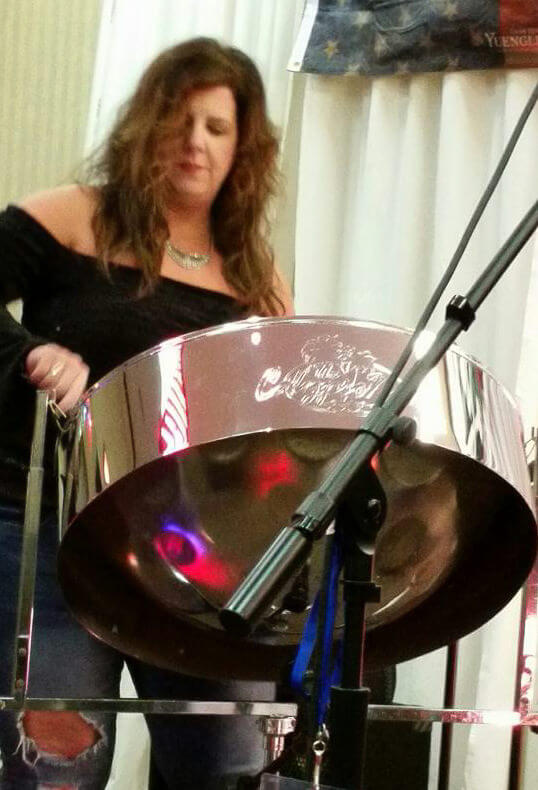
Angel Lawrie
Angel L. - “I have an eclectic taste in music. My inspiration comes from everywhere. I love Jazz, Classical, Rock, Country, Calypso and Reggae. I believe all music has something to say if you listen closely enough. I am influenced by any musician who is true to self, and to their music.”
WST - “You’ve performed on cruise lines - share on some of your experiences.”
Angel L. - “I had the honor to perform on cruise ships both locally and abroad in the 80s. I loved being able to see other countries, and to experience meeting people from all over the world. Playing a cruise ship requires being able to deliver each night and come up with new things for audiences that have the opportunity to see you several times. Creativity is key.”
WST - “Your love for, and skill with, the steelband art form, have taken you around the world; share on some of those engagements, how they came about, the reception, etc.”
Angel L. - “I have been fortunate enough to travel and perform in Trinidad, Italy, Canada, and the USA. What I love about this instrument is that it puts a smile on every person who listens no matter where you are performing. The sound transforms them to a warm, happy place. Those travel experiences taught me about life, and broadened my perception of the world.”
WST - “Talk about your book, “Steel Angel - the life of a woman etched in steel.””
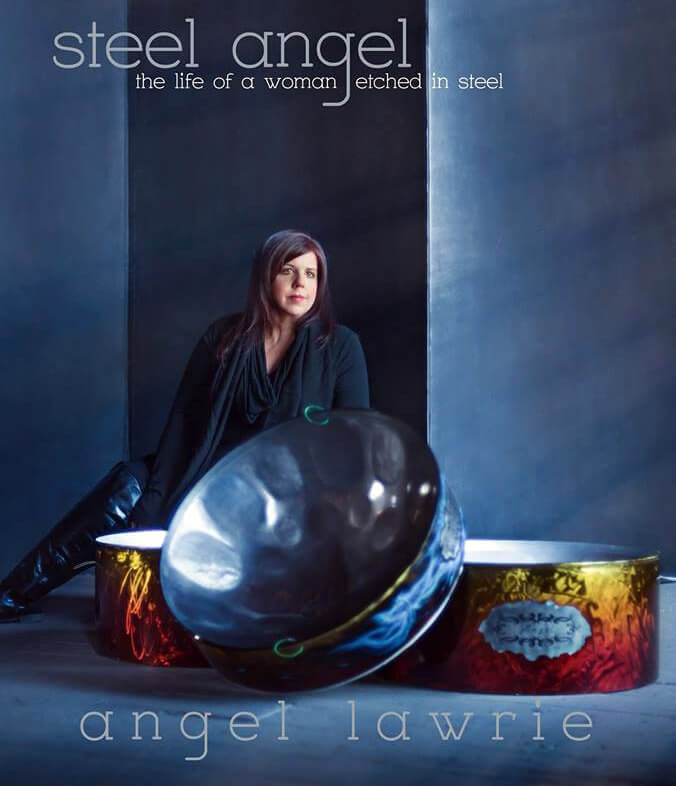
Angel L. - “I have released part one of my book this year. I released it unedited because I wanted the people who were interested in my story to see what it felt like to survive as a woman with ADHD. The struggles I wrote about are the very reason I relate to my students, and what they are feeling and experiencing. Along with my CD released in 2000, I was hoping to inspire others to share their stories as well.”
WST - “What keeps your passion for pan going?”
Angel L. - “I have dedicated my life to pan, and it has brought me incredibly inspiring moments, and moments of sadness. I would not change a thing. When I felt like giving up, my pan was always there. Whether it was paying for college tuition or helping me achieve the next great thing. It was my reason to keep trying. Pan is not just a hobby for me. It is my way of life. It has affected every area of my life from professional to personal.”
WST - “Can you share some of your more memorable moments regarding Pan?”
Angel L. - “Playing Fire Down Below with “Boogsie” Sharpe. Asking Harry Belafonte to come and give a concert with me to support my kids, and him showing up, and performing with us. Selling out a 1000-seat concert in Racine, Wisconsin after just being there a year. Appearing on television - both network and PBS. Writing my book. Planning and hosting the very first International Association of Pan Festival in Akron, Ohio and having most tuners together for the first time in the USA. Playing pan with my husband at our wedding. Playing pan in the Rockies in the middle of a snow storm. Playing pan for the hundreds of wonderful senior citizens who showered me in love. Helping my first student with Autism. Planning all of my pan events with headliners I choose to visit. Hosting pan groups in my home as they travel through on their journeys. Many pan players have rehearsed in my basement and sat with me at my dinner table. Almost every experience has brought me joy.”
WST - “What have you been most proud about as it relates to Pan?”
Angel L. - “The feeling of family, and the sense of accomplishment that each pan experience brings me.”
WST - “What about the steelband art form do you find most disappointing?”
Angel L. - “In the beginning, it felt like there was a lot of competition for recognition in the field, or to be the so-called ‘first’ to do things in pan. I felt like that attitude halted the beauty and growth of the instrument and really only fed egos. Since my initial involvement in 1986, I feel that is changing a lot.”
WST - “What excites you the most, and/or makes you most proud about being affiliated with the art form?”
Angel L. - “The steady growth of the art form, and the feeling of warm family as we concentrate on education and helping students benefit from the music itself.”
WST - “Do you think the steelband community and its musicians are well regarded/respected?”
Angel L. - “I think that very topic is getting better every day. Organization, teamwork, and mindfulness of all who are involved will continue that process, and allow it to grow.”
WST - “What is your vision for the steelband art form a decade from now?”
Angel L. - “I would like to see the Steel Band be accepted in all countries with the same weight as any other percussive instrument, and for the rich history behind it to be properly preserved.”
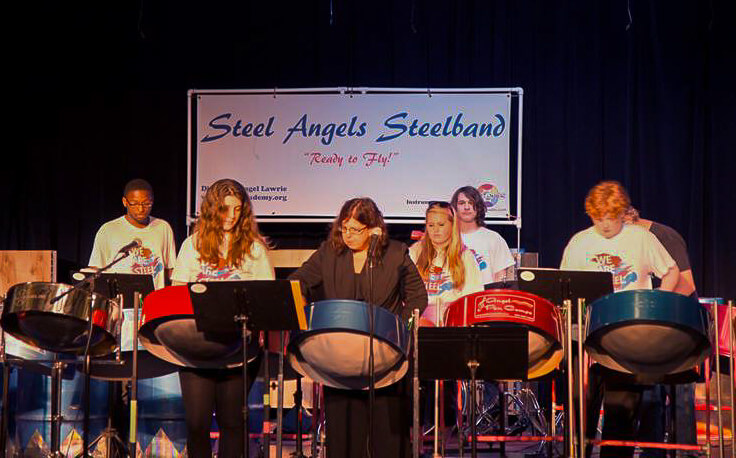
Angel Lawrie, center, with band
WST - “If you could change one thing about pan what would that be?”
Angel L. - “I would love to see pan be an affordable and accessible entity for all schools.”
WST - “What advice would you give to anyone dreaming of becoming involved with the art form as a career move - either as performing artist, or educator?”
Angel L. - “Network with your peers. Be open-minded, and do not be afraid to be an individual as well. Experiment with the instrument and adapt it into your pedagogy or performing career in new and exciting ways.”
WST - “Are there any other steelband-related matters you would like to bring forward?”
Angel L. - “ I would like to send all my love to all of my pan family, and just say that it is an honor to be part of this beautiful art form. We can all learn from Pan. We may start out as feeling used-up, or forgotten, but with love, skill, and hard work, you can be anything you want to be, and it is possible to change the world one note, one person, one instrument at a time!”
photos utilized with the permission of Angel Lawrie
Their Story, Their Voice, Their Life, Their Dreams - click for more stories
Leave a comment in the WST forum








